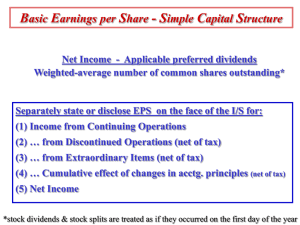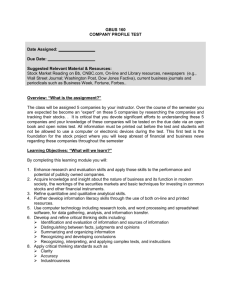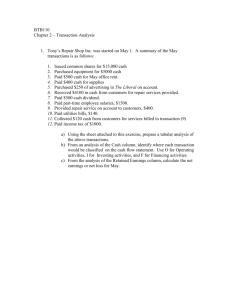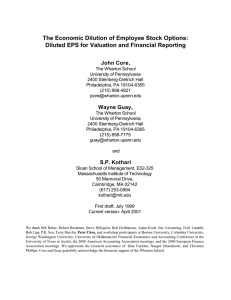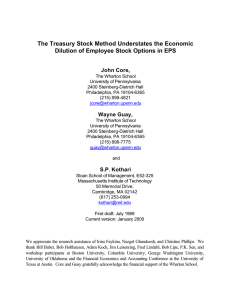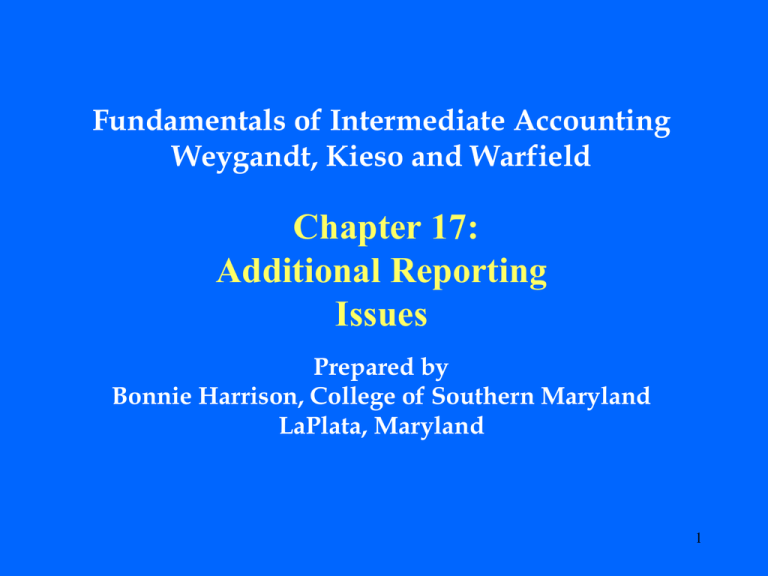
Fundamentals of Intermediate Accounting
Weygandt, Kieso and Warfield
Chapter 17:
Additional Reporting
Issues
Prepared by
Bonnie Harrison, College of Southern Maryland
LaPlata, Maryland
1
Chapter 17
Additional Reporting Issues
1
2
3
4
After studying this chapter, you should be able to:
Describe various accounting changes.
Understand how to account for cumulative-effect
accounting changes.
Understand how to account for retroactive
accounting changes.
Describe the accounting for changes of estimates.
2
Chapter 17
Additional Reporting Issues
After studying this chapter, you should be able to:
5 Describe the accounting for correction of errors.
6 Compute earnings per share in a simple capital
structure.
7 Compute earnings per share in a complex capital
structure.
3
Types of Accounting Changes
The types of accounting changes are:
Changes in Accounting Principle
Changes in Accounting Estimates
Errors in Financial Statements
4
Changes in Accounting Principle
A change in principle involves a change
from one generally accepted principle to
another
A change in principle does not result from
the adoption of a new accounting principle
A change to a generally accepted principle
(from an incorrect principle) is a correction
of an error
5
Changes in Accounting Principle
Changes in accounting principle are classified
into:
Cumulative-effect type of accounting
change
Retroactive-effect type of accounting
change
Change to the LIFO method of inventory
6
Cumulative-Effect Type of Accounting
Change
The catch up method should be used to account
for these changes
Financial statements for prior periods are not
restated
For all prior periods, the following items are
shown on an as-if basis (as if the new principle
had been applied):
income before extraordinary items
net income
7
Cumulative-Effect Type of Accounting
Change
The adjusting entry is effective as of the
beginning of the year
Pro forma information is shown only as
supplementary information
Such information may be reported:
1)
in the income statement
2)
in a separate schedule
3)
in the notes to the financial statements
8
Cumulative Effect: Example
• XYZ company changes from the sum-of-theyears’ digits method to the straight line method of
depreciation.
• The depreciation amounts are:
Year
SYD
ST.LINE
2002
$15,000
$8,000
2003
$14,000
$8,000
• The company’s tax rate is 40%
• Record the change as of the beginning of 2004
9
Cumulative Effect: Example
• Year
SYD
• 2002
• 2003
$15,000
$14,000
SL
Diff
Tax
Effect
$8,000 $7,000 $2,800
$8,000 $6,000 $2,400
-------- -------$13,000 $5,200
-------- --------
• Tax effect is the difference times the tax rate
10
Cumulative Effect: Example
•
•
Journal Entry:
Accumulated Depreciation $13,000
Deferred Tax Asset
$5,200
Cumulative Effect of
Change in Principle
$7,800
1) The debit to accumulated depreciation is the
excess of SYD over the straight line basis
2) The credit to Cumulative Effect is the income
effect (net of tax effect)
11
Income Statement Presentation
The following information must be presented in
whole dollar amounts and as per share amounts:
o Income before Extraordinary Item
and Cumulative Effect of Change :$ XXX
o Extraordinary Item (Net of Tax)
:$ XX
o Cumulative Effect on Prior Years
of Retroactive Application
:$ XX
o Net Income
:$ XX
12
Retroactive-Effect Type of Accounting Change
The cumulative effect of the new method at the
beginning of the period is determined
Prior period statements are recast based on the
new principle
Any cumulative effect of prior periods is adjusted
to the beginning retained earnings balance
13
Retroactive-Effect Type of Accounting Change
The five situations requiring restatement of all prior period
statements are:
1. A change from the LIFO inventory method to another
method
2. A change in the method of accounting for long term
construction type contracts
3. A change from or to the full cost method in extractive
industries
4. Issue of financials to obtain first time financing
5. A pronouncement recommending retroactive adjustment
14
Retained Earnings Presentation
• Retained Earnings account is shown as follows:
• Balance at beginning of year
• Adjustment for the Cumulative
Effect on Prior Years
• Balance at beginning (as adjusted)
• Net Income
• Balance at end of year
:$ XXX
:$ XX
:$ XX
:$ XXX
:$ XXX
15
Reporting a Change in Estimate
Changes in estimates are accounted for on a prospective
basis
Such changes are viewed as normal, recurrent adjustments
When uncertainty exists as to whether a change in
principle or a change in estimate has occurred:
•
the change should be treated as a change in estimate
Estimates that are later determined to be incorrect should
be corrected as changes in estimates
Examples of changes in estimates involve:
• inventory obsolescence; salvage values of assets,
uncollectible receivables, liability for warranties and taxes
16
When is a Change in Accounting Principle Appropriate?
Changes are appropriate when the changed
principle is preferable to the existing accounting
principle
The changed principle should result in improved
financial reporting
A change is considered preferable if a FASB
standard:
creates a new accounting principle, or
expresses preference for a new principle, or
rejects a specific accounting principle
17
Reporting the Correction of an Error
Corrections are treated as prior period adjustments to
retained earnings for the earliest period being reported
Examples of accounting errors are:
1) A change from an accounting principle that is not
generally accepted to one that is accepted
2) Mathematical errors
3) Changes in estimates that were not prepared in good
faith
4) A failure to properly accrue or defer expenses or
revenues
5) A misapplication or omission of relevant facts
6) Incorrect classification of cost as expense or asset
18
Earnings Per Share
EPS indicates the income earned by each share of
common stock.
Reported only for common stock.
Dilution of EPS means reduction in EPS.
Reduction in EPS results from potential conversion
of dilutive securities into common stock.
Shareholders want to know the extent of reduction in
EPS, if dilution takes place.
19
E.P.S
• BASIC E.P.S:
NET INCOME - PREFERRED DIVIDEND
------------------------------------------------------------WEIGHT.AVERAGE OUTSTANDING.
COMMON SHARES
20
Basic EPS Computations: Example
Given:
Jan 1: 500,000 shares outstanding.
May 1: Issued 84,000 shares.
Sept 1: Reacquired 42,000 shares.
Nov 1: Issued 36,000 shares.
N.Inc [to common stock]: $654,000.
Determine the earnings per share.
21
Basic EPS Computations: Example
Jan 1:
May:
Sept 1:
Nov 1:
500,000 *
584,000 *
542,000 *
578,000 *
Total W.Avg.shares
4/12
4/12
2/12
2/12
=
=
=
=
166,667
194,666
90,333
96,334
548,000
Earnings per Share = $654,000 / 548,000 shares
= $1.19
22
Stock Dividends and Splits
Stock dividends and stock splits require restatement
of weighted shares outstanding before the dividend
or split.
Stock dividends or splits during the year are deemed
to have been outstanding since the beginning of
the year.
Stock dividends or splits after end of the year but
before issue of the financials are likewise deemed to
be outstanding since the beginning of the year.
23
What is “DILUTION?”
• “DILUTION” is the reduction in E.P.S, if:
securities, potentially convertible into
common stock, are converted [assumed
at beginning of the year].
• Two EPS amounts are important:
Basic and Diluted
24
Complex Capital Structures
• Complex structures have convertible
securities, options, warrants, or other rights
that reduce earnings per share.
• Only securities that reduce earnings per
share (dilutive) are considered.
• Securities that increase earnings per share
(antidilutive) are ignored.
25
Diluted Earnings per Share: Methods
• The dilutive effect of convertible securities is
measured by the if-converted method
• The dilutive effect of options and warrants is
measured by the treasury stock method
• For computing dilution, the rate of conversion
most advantageous to the security holder is
used (maximum dilutive conversion rate)
26
The If-Converted Method
• The conversion of the securities into common
stock is assumed to occur at the beginning of
the year
• The related interest effect (net of tax) is
removed from net income
• The weighted average number of shares is
increased by the additional common shares
assumed issued (at the beginning)
27
The Treasury Stock Method
Options and warrants (and their equivalents) are
included in EPS computations
Options and warrants are assumed exercised at the
beginning of the year
The proceeds from the exercise of options are
assumed used to buy back common shares
The exercise price per share must be less than the
market price per share for dilution to occur
28
Options and Warrants:
Treasury Stock Method
Given:
Exercise price of an option :
[for one share of stock]
Market price of one share
at Exercise date:
Options deemed exercised:
$ 10
$ 40
1,000
Compute the number of weighted shares for determining
diluted earnings per share
29
Options and Warrants:
Treasury Stock Method
Total proceeds from exercise:
$10,000
Shares assumed issued upon exercise: 1,000
Assumed reacquisition of shares:
250
DILUTION: 1,000 - 250 = 750 SHARES
(increase in outstanding shares)
30
Earnings per Share: Simple Capital
Structures - Summary
1
2
Single Presentation of EPS
Net Income less Preferred Dividends
3 Weighted Average Number of Common Shares Outstanding
4
EPS = Result in Step 2
Result in Step 3
31
Earnings per Share: Complex Structures Summary
Dual EPS Presentation
Basic EPS
Net Income adjusted for interest
(net of tax) and preferred dividends
-----------------------------------------Weighted average number of
common shares assuming maximum
dilution
Diluted EPS
Dilutive Convertibles
Dilutive Options and
Warrants
Dilutive Contingent
Issues
32
COPYRIGHT
Copyright © 2003 John Wiley & Sons, Inc. All rights
reserved. Reproduction or translation of this work beyond
that named in Section 117 of the 1976 United States
Copyright Act without the express written consent of the
copyright owner is unlawful. Request for further information
should be addressed to the Permissions Department, John
Wiley & Sons, Inc. The purchaser may make back-up copies
for his/her own use only and not for distribution or resale.
The Publisher assumes no responsibility for errors,
omissions, or damages, caused by the use of these
programs or from the use of the information contained herein.
33


